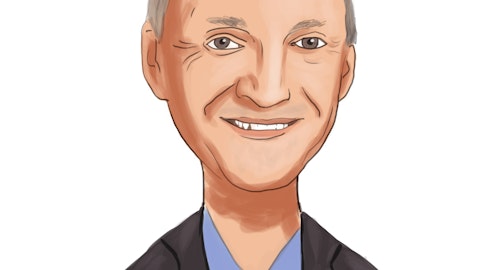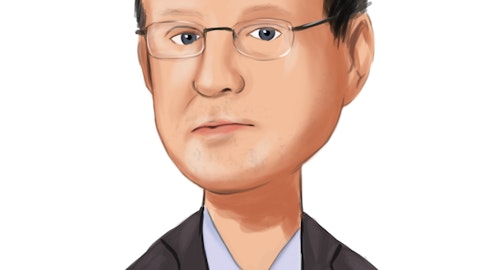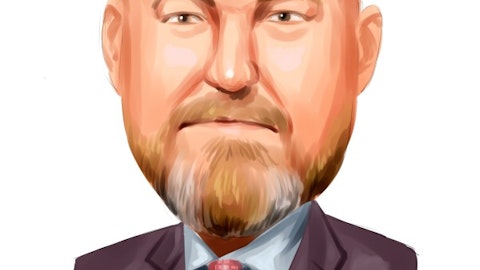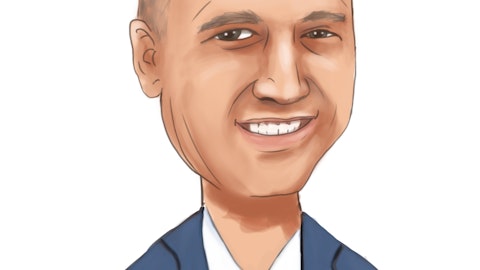Jared Shaw: Yeah. Maybe starting with Vince, your comments on utilizing analytics to help drive the deposit base. Can you give us some examples of how you’re doing that and your deposit performance has been really strong, your beta among the best in the group so far. I guess — how are you getting that and is that going to be a sustainable level or a sustainable avenue of growth as we go forward.
Vince Delie: Yes. This is Vince Delie actually, Steve mentioned that in his comments and I will tell you, we’ve made a significant investment in our ability to analyze large quantities of data. We’ve talked about that before. We have the data. We have an entire team that manages the governance and systems. We’ve invested early and heavily in that area over the last five or six years. We use that team to basically give us a better understanding of the types of clients that we have and to really drill into client behavior expectation and it enables us to be able to provide them with better solutions. And the answer on the deposit stability and growth, I think we’re an outstanding deposit franchise. I think if you look at the mix, the mix is very strong relative to the peers.
The stability of the demand deposit base is very strong. The granularity is strong. So there’s quite a bit that goes into managing a deposit portfolio of that size. There’s not just one silver bullet. So we focus — we use analytics to focus on treasury management opportunities within our customer base. We use the analytics to view customers that are single source or single product customers that may have a loan product that don’t have a fuller depository relationship with us. We use the analytics tool to tier the clients based upon need that helps us direct our resources more effectively to drive growth. We also use the analytics tool with our digital offering so that we can present products and services to clients as they engage the eStore online.
I mentioned in my comments, we had 500,000 views on the website and on the mobile app because our eStore is embedded into our mobile application. So it’s right there for the customers to engage with, that — all of that helps us manage the betas and the deposit outflows and deposit growth and the mix of the deposits. So it’s a pretty complex set of strategies that we deployed and the tactics that underlie the strategy in each segment really are geared towards driving better performance in that deposit portfolio. Hopefully, that answers your question. That’s pretty flat
Jared Shaw: That was great color. Maybe looking at margin, you project or you expect a couple more 25 basis point hikes. What’s your expectation for DDA diminishment in that scenario? And are you taking any steps to protect margin if we start shifting to more of an expectation for lower rates in the future?
Vince Calabrese: Yeah. I would start with just the non-interest bearing deposits, again, are a big focus in the company. So our ability, as you can see here in my prepared remarks, I mean, EAs were down 1% or so less for the quarter that takes a lot of effort. All the tools that Vince talked about analytically as well as our team on the front line and our relationships with customers that are very strong. We’ve created a lot of goodwill going to PPP. We’re in that process with existing customers and new customers that we’ve been broadening relationships with. So that — those relationships and our customers’ willingness to talk to us and if they’re looking to move money instead of just moving money is very valuable. And our team on the front line has been very active throughout the fourth quarter.
Talking to customers. We have a large corporate initiative that’s been on the lending side as well as the deposit side. That has been bearing fruit during the quarter. So our goal is to sustain the DDAs and continue to grow them from here. We have a slide in there that shows a percent of full deposits from 16% up to 34%. Our team is incented to work hard to grow those non-interest bearing deposits.
Vince Delie: We have a lot of tools in place, but why don’t you mention also our active asset liability strategy, a focus on preserving margin.
Vince Calabrese: Yeah. I would say we as you would expect, I mean our treasury team studies at daily. I mean we’ve been looking at hedging opportunities really for the last year, and we did some small amounts of hedging, I don’t know, six months or so ago, but decided not to put more on because of where levels were and what was expected to happen with rates. You don’t have to go back that far when everybody was locked in that rates are just going to fall off a cliff one quarter or two quarters into the year and then the protection and that became very expensive. So we’ve put some on. Naturally, our asset sensitivity has been kind of approaching neutral. If you look at the asset sensitive our interest rate risk position, you’re down to like 1% or so for plus 100, minus 100.
So organically, it’s been kind of coming down as we’ve been deploying cash just kind of the natural movement of the balance sheet. So we’ll continue to monitor it, Jared. But at this point, the price points haven’t made sense to us to load up on hedges for the balance sheet. But we’ll continue to look at it and we’ll be smart about it when it makes sense. And if it does make sense to us, we’ll put something done. We’ve done about $1 billion or so of received fixed swaps over the recent period. So we have that component there. But the natural asset sensitivity coming down, and as you know, net interest income is at a much higher base. So it’s kind of coming off of that. So having that lower interest rate risk a more neutral interest rate risk position is a positive and as we move forward.
So we’ll continue to monitor as we have and evaluate any hedging opportunities that make sense. But the main deposits are always valuable and in this environment, we’re even more valuable. So our team’s success in growing those non-interest bearing deposits, which is key for us, and that will always be a focus.
Jared Shaw: Okay. Thanks. And just finally for me, just on the capital management side. What’s the appetite for M&A here? And maybe, Vince, what’s your view of sort of the current state of bank mergers overall?
Vince Delie: But I think I wouldn’t want to be an investment banker in the short run here. I think it’s been a pretty challenging environment. Investment banking fees, in general, was down 20%, given what’s happened with AOCI is that level it becomes very challenging to do a deal that’s accretive that doesn’t have substantial relevance to it. And we’ve stated repeatedly that we’re not interested in diluting tangible book value. We have as Vince said, we have capital flexibility that we’ve never had before, which could mean a number of things and we did become more aggressive in buying shares back if loan growth slows, if you look at the dividend payout ratio on an operating basis, we’re down to 34% unheard of it. I mean we took the reins here 80% — 70%, 80% payout ratio.
So we have incredible flexibility moving forward. We want to make sure it benefits our shareholders. So our focus is just driving shareholder returns and making sure that we’re making smart decisions with capital so that we can move the stock price up and repatriate appropriate levels of capital at some that’s the strategy moving forward.
Jared Shaw: Great. Thanks.





